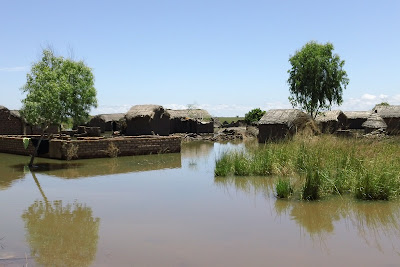 Les déplacés du Nord du Mali se retrouvent dans des conditions précaires à Ségou
Les déplacés du Nord du Mali se retrouvent dans des conditions précaires à Ségou
Par Ulrike Dassler, Chargée de l'Information Publique
OCHA MALI
Les déplacés du nord de Mali vivent dans des conditions très précaires à Ségou dans le sud du pays. La ville a vu sa population augmenter de 36 000 personnes, dont 11 000 enfants, suite aux déplacements déclenchés par l’arrivée des groupes armés islamistes au nord il y a un an de cela. Les affrontements entre les groupes islamistes et l’armée gouvernementale et les forces françaises au début de 2013 ont créé une deuxième vague de déplacement.
Malgré l’aide humanitaires fournie par les ONGs, les déplacés à Ségou peinent aujourd’hui à trouver les moyens de survivre et d’assurer la scolarisation de leurs enfants.
 |
| Mariam a toujours peur de rentrer à Kidal |
Mariam, une mère de huit enfants, est l’une des déplacées du Nord. Deux semaines après que les islamistes d'Ansar Dine aient occupé la ville de Kidal en avril 2012, Mariam a réussi à s'échapper. Par chance, elle est arrivée à Ségou, près de 1000 km au sud, au bord du fleuve Niger. Dans un premier temps, elle est restée avec des parents qui ont généreusement partagé leur appartement et repas avec elle et ses enfants. Mais après quelques mois, la maison s’est rapidement remplie avec l’arrivée d’autres femmes Touareg déplacées et Mariam a dû se résoudre à trouver un autre toit. Elle loue maintenant une petite maison pour 20 dollars par mois, ce qui représente une somme importante puisqu’elle n’a aucune source de revenu.
« Nous n’arrivons pas toujours à payer le loyer. Aujourd’hui nous avons trois mois de retard, mais le propriétaire est gentil avec nous, il sait que nous n'avons rien », explique Mariam. Chaque jour, Mariam espère pouvoir retourner dans sa maison à Kidal, à la frontière de l'Algérie, avec ses enfants.
 |
| Les déplacés dorment en général à plusieurs dans une pièce de 5 m2 |
Les ONGs nationales et internationales distribuent du riz, de la farine et de l'huile et de nombreux dons privés des commerçants de Ségou arrivent tous les jour, mais malgré tout celà il n’y a pas assez de vivres pour tous les déplacés à Ségou. Une famille, comportant majoritairement des femmes et des enfants, est habituellement composée de 10 à 20 personnes alors que l’assistance alimentaire du Programme Alimentaire Mondial à Ségou est calculée sur la base de rations pour cinq personnes seulement.
L’éducation pose également un problème pour Mariam. Même si ses cadets ont la possibilité de poursuivre leur scolarité avec l’école primaire à proximité, les deux aînés ont dû arrêter l’école, le lycée étant maintenant trop éloigné et le transport trop coûteux.
Pour plus d'informations visitez http://www.unocha.org/mali/
















.jpg)



